Introducing children to the world of gardening can be a rewarding and educational experience. In today’s fast-paced, technology-driven world, getting kids involved in gardening can offer a hands-on opportunity to learn about nature, responsibility, and patience. This article will explore various gardening container ideas for kids, providing insights into the benefits of gardening for children’s development.
Gardening offers numerous benefits for children, including enhanced sensory experiences, improved physical health, and opportunities for creativity and self-expression. Through engaging in gardening activities, kids can develop important life skills such as patience, responsibility, and problem-solving. Additionally, spending time outdoors and connecting with nature has been shown to have a positive impact on children’s mental well-being.
When it comes to setting up a kid-friendly garden, choosing the right containers is essential. Containers should be safe, lightweight, and easy for children to handle. Furthermore, selecting containers that are colorful or customizable can add an extra element of fun to the gardening experience. In the upcoming sections of this article, we will explore creative container gardening ideas and DIY projects that are perfect for kids looking to cultivate their green thumbs.
Benefits of Gardening for Children’s Development
Physical Development
Engaging in gardening activities can significantly contribute to children’s physical development. Whether it’s digging, planting, or watering, these tasks help improve their fine motor skills and hand-eye coordination. In addition, spending time outdoors and getting their hands dirty promotes better sensory and tactile experiences that are essential for overall physical growth.
Mental Well-Being
Gardening has been proven to have positive effects on children’s mental well-being. The act of nurturing plants and watching them grow can instill a sense of responsibility and accomplishment in kids. It also provides a calming and therapeutic outlet that helps reduce stress and anxiety levels. Gardening teaches patience, resilience, and problem-solving skills, which are valuable lessons for children to learn.
Social Skills
Another significant benefit of gardening for children is the opportunity it provides for social interaction. Working on a gardening project with friends or family members encourages teamwork, communication, and cooperation. Kids learn how to share tasks, take turns, and support each other in achieving common goals. Gardening together fosters a sense of community and belonging that can positively impact children’s social skills and relationships.
Choosing the Right Containers for Kid-Friendly Gardening
When it comes to gardening with kids, choosing the right containers is essential for a successful and enjoyable experience. Kid-friendly gardening containers should be safe, durable, and ideally easy for children to handle. Here are some great options to consider:
- Plastic Pots: Lightweight and easy to move around, plastic pots are a practical choice for kids’ container gardens. They come in a variety of sizes and colors, allowing children to personalize their gardening space.
- Raised Beds: Raised beds are excellent for teaching children about proper soil drainage and plant spacing. They also make it easier for kids to reach their plants without bending over too much.
- Hanging Baskets: Hanging baskets add a fun element to gardening and are perfect for growing colorful flowers or trailing vines. Kids can learn how different plants cascade as they grow.
Additionally, when selecting containers for kids’ gardens, it’s essential to consider factors such as size, drainage holes, and the material of the container. Make sure the containers are large enough for plants to grow comfortably and have adequate drainage to prevent waterlogging. Also, opt for non-toxic materials that won’t harm children if touched or ingested.
Moreover, involving children in the process of choosing containers can spark their interest in gardening. Let them pick out containers in various shapes or designs that appeal to them personally, encouraging creativity and ownership over their garden space. By selecting suitable containers together with kids, you can make the gardening experience more exciting and engaging for them.
Creative Container Gardening Ideas for Kids
Container gardening is a fantastic way to introduce children to the world of gardening. Not only does it provide a hands-on learning experience, but it also allows kids to get creative and express themselves through their plant arrangements. Here are some creative gardening container ideas for kids to get them excited about growing their own plants:
- Mini Fairy Gardens: Create enchanting mini fairy gardens in containers using small plants, figurines, and decorative pebbles. Kids will love designing magical landscapes and watching their fairy gardens come to life.
- Pizza Garden: Plant different herbs like basil, oregano, and cherry tomatoes in a circular container to mimic the ingredients of a pizza. This fun and interactive project will not only teach kids about where food comes from but also inspire them to cook with fresh herbs from their garden.
- Painted Plant Pots: Let kids unleash their creativity by painting plain terracotta pots with colorful designs or patterns. Personalized plant pots add a special touch to any container garden and make great gifts for family and friends.
Encouraging children to explore different gardening container ideas not only stimulates their imagination but also fosters a sense of responsibility as they care for their plants. Whether it’s creating themed gardens or experimenting with unconventional containers, the possibilities are endless when it comes to engaging kids in the wonderful world of gardening.
Keyword used: gardening container ideas for kids
DIY Container Projects for Children
Recycled Container Creations
Encourage children to get creative by using recycled materials to make their own gardening containers. From old soda bottles and cans to milk cartons and yogurt cups, there are plenty of options for upcycling everyday items into planters. This not only teaches kids about sustainability but also sparks their imagination as they come up with unique designs for their garden containers.
Fairy Garden Terrariums
Transform a simple glass jar or container into a miniature world with a fairy garden terrarium project. Children can gather small pebbles, soil, tiny plants like succulents or moss, and cute figurines to create their own magical indoor garden. This DIY project allows kids to learn about ecosystems, plant care, and design while engaging in imaginative play.
Painted Plant Pots
Provide children with plain terra cotta pots and craft supplies like acrylic paints, brushes, and stickers for them to personalize their own planters. This hands-on activity not only allows kids to express themselves artistically but also gives them a sense of ownership over their gardening projects. They can unleash their creativity by painting designs, patterns, or even labeling the pots with the names of the plants they are growing.
Engaging children in DIY container projects not only enhances their gardening experience but also instills valuable skills such as creativity, resourcefulness, and responsibility. These fun and hands-on activities allow kids to take pride in creating something unique while fostering a love for nature and gardening at a young age.
By involving children in the process of making their own containers, they will develop a deeper connection to the plants they grow and be more invested in caring for them as they watch them thrive.
Easy-to-Grow Plants for Kids’ Container Gardens
Plant selection is a crucial aspect when creating a container garden tailored for kids. Choosing plants that are easy to grow, visually appealing, and engaging can enhance children’s gardening experience and keep them excited about the process. Some of the best plants for kids’ container gardens include sunflowers, cherry tomatoes, strawberries, and herbs like basil and mint.
Sunflowers are a popular choice for kids as they are easy to grow from seeds and can reach impressive heights that children will find fascinating. Cherry tomatoes and strawberries not only provide a delicious reward but also teach children about growing their food. Herbs like basil and mint are not only aromatic but also fast-growing, making them perfect for young gardeners who want to see quick results.
In addition to these plant options, consider incorporating plants with different textures, colors, and scents to engage all of the child’s senses in the gardening process. For example, fuzzy lamb’s ear leaves or fragrant lavender can add sensory interest to the container garden. By selecting a variety of plants that cater to children’s curiosity and sense of wonder, you can create an exciting and educational gardening experience for them.
| Plants | Description |
|---|---|
| Sunflower | Easy to grow from seeds and reach impressive heights. |
| Cherry Tomatoes | Delicious reward while teaching about growing food. |
| Strawberries | Provide a tasty treat while being easy to care for. |
| Basil & Mint | Aromatic herbs that are fast-growing and engaging. |
Teaching Kids About Plant Care and Maintenance
One of the most important aspects of getting kids involved in gardening is teaching them about plant care and maintenance. This not only helps instill a sense of responsibility in children, but also educates them on the needs of different plants.
One effective way to teach kids about plant care is by involving them in watering schedules. Show them how to check the soil for moisture levels and explain the importance of providing just the right amount of water for each plant.
Another key aspect of plant care that kids can learn is pruning and grooming. Teach them how to deadhead flowers, trim overgrown branches, and remove any damaged leaves. This hands-on approach not only helps kids develop fine motor skills, but also encourages them to observe the plants closely and take note of their growth patterns.
Additionally, educating kids about fertilizing and repotting plants can further enhance their gardening skills. Explain to them the importance of nutrients for plant growth and demonstrate how to responsibly apply fertilizer. Engage them in the process of repotting plants when they outgrow their containers, teaching them how to handle roots delicately and provide adequate soil for growth.
When it comes to teaching kids about plant care and maintenance, hands-on experience is key. By involving children in these tasks from a young age, they will develop a greater appreciation for nature, learn valuable skills, and grow into responsible caretakers of their own gardening container ideas for kids.
| Aspect | Details |
|---|---|
| Watering Schedules | Show kids how to check soil moisture levels |
| Pruning and Grooming | Teach kids how to deadhead flowers and trim overgrown branches |
| Fertilizing and Repotting Plants | Explain the importance of nutrients; involve kids in repotting plants when necessary |
Fun and Educational Activities to Enhance Kids’ Gardening Experience
Engaging children in gardening activities is not only beneficial for their physical and mental development, but it can also be a fun and educational experience for them. There are several activities that parents or educators can incorporate to enhance kids’ gardening experiences.
One idea is to have children create a garden journal where they can document their planting progress, observations, and any new things they learn along the way. This journal not only encourages them to write and draw, but also helps them track the growth of their plants over time.
Another fun and educational activity for kids’ gardening experiences is organizing a garden scavenger hunt. Parents can create a list of items for children to find in the garden, such as different types of leaves, flowers, insects, or even specific plant parts like seeds or roots. This activity not only gets kids moving and exploring nature but also helps them learn more about the plants in their garden and develop their observation skills.
One more idea to enhance children’s gardening experience is to involve them in cooking with the produce they grow. Kids can harvest vegetables or herbs from their container gardens and then help prepare simple dishes with them.
This hands-on experience not only teaches children where food comes from but also introduces them to basic cooking skills and encourages them to eat fresh, healthy produce. By incorporating these fun and educational activities into kids’ gardening experiences, parents can foster a love for nature, cultivate important life skills, and create lasting memories with their children.
Conclusion
In conclusion, gardening is a wonderful activity for children that not only provides numerous developmental benefits but also fosters a lifelong love for nature and the environment. By engaging in gardening activities, kids can learn valuable skills such as patience, responsibility, and the importance of caring for living things. The process of planning, planting, and maintaining their own container gardens can be incredibly rewarding and educational for young minds.
When it comes to gardening container ideas for kids, there are countless creative options to explore. From repurposing old toys as planters to decorating pots with colorful designs, the possibilities are endless. Encouraging children to take ownership of their garden containers by allowing them to personalize and customize their space can further enhance their sense of pride and connection to their plants.
As parents and educators, it is important to continue nurturing children’s interest in gardening by providing ongoing support and guidance. Offering opportunities for kids to experiment with different plants, expand their knowledge through educational activities, and celebrate their gardening successes can help instill a lifelong passion for green spaces.
By introducing children to the joys of growing their own plants in fun and engaging ways, we can inspire the next generation of environmental stewards who will appreciate the beauty and importance of nature.
Frequently Asked Questions
What Vegetables Grow Best in a Kiddie Pool?
Vegetables that grow best in a kiddie pool are typically those with shallow roots and do not require too much space to spread out. Some examples include lettuce, radishes, spinach, and herbs like basil or parsley. These plants thrive in the limited space provided by a kiddie pool and can be easily grown by beginner gardeners.
What Is the Cheapest Way to Make a Container Garden?
The cheapest way to make a container garden is to repurpose items you already have at home. Look around for buckets, old pots, jars, or even wooden crates that can be used as containers for your plants. Additionally, you can save money by using compost from your kitchen scraps or making your own DIY potting mix.
What Foods Are Good for Container Gardening?
When it comes to foods that are good for container gardening, versatility is key. Herbs like mint, basil, thyme, and chives are great choices as they can be used in various culinary dishes and cocktails. Additionally, vegetables like tomatoes, peppers, cucumbers, and leafy greens such as lettuce or spinach do well in containers due to their compact growth habits.

Welcome to my gardening blog! I am passionate about plants and enjoy sharing my knowledge and experiences with others. In this blog, I will write about everything related to gardening, from tips on how to get started to updates on my own garden projects.





